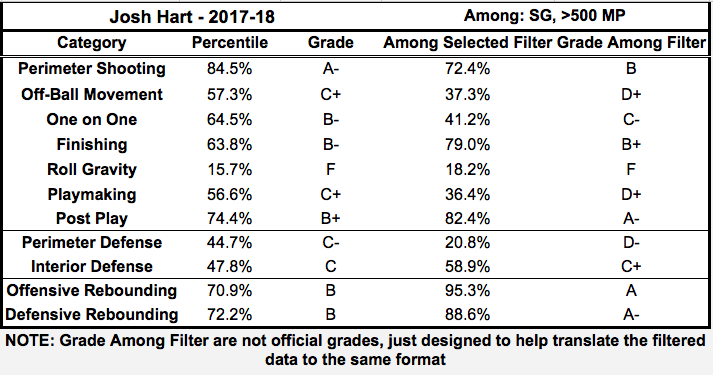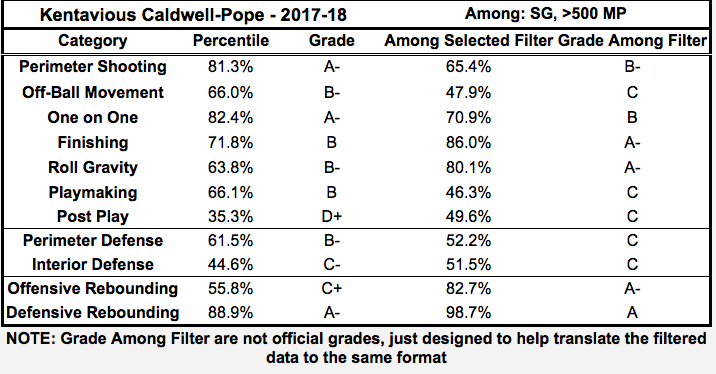In sports, and in life, competition is almost never a bad thing.
There are instances when competitiveness can even go as far as optimizing an individual’s skills, and bolster the environment in which they belong. The Los Angeles Lakers seem to be banking on this exact notion this season.
The team’s roster construction seemingly encourages this level of vying with both a talented young core and a crop of wily veterans. Throughout the offseason, the only certainty regarding the rotation had been, and continues to be: LeBron James will start, and finish games.
With preseason play now officially over, the team’s murky projected starting lineup has clarified somewhat. The only real question remaining is: Who will be starting at shooting guard?
The team has the fortunate dilemma of having two viable options to consider.
There is five-year guard, Kentavious Caldwell-Pope, and last season’s 30th-overall-pick, Josh Hart. Both of whom showed enough promise last season to make worthwhile cases in why they belong in the starting five.
Similar in many regards, the two also have polarizing strengths and weaknesses. To better understand what each can offer the Lakers at shooting guard, let’s take a look at the tale of the tape:
Offensive Talents
A simple glance at BBall-Index‘s talent grades from last season can be quite revealing.
When comparing the two players amongst shooting guards who played in at least 500 minutes, their individual talents in the given role become more comprehensive.

The areas in which Hart’s individual offensive talents ranked highest within this filtration were his: Perimeter Shooting (72.4%) Finishing (79%) Post Play (82.4%) and his Offensive Rebounding (95.3%).
Hart showed impressive shooting chops as a rookie, representing one of the few Lakers who made defenses pay for anything less than a tight cover.
Possessing a good counter to hard closeouts, and in transition, Hart’s bulldozing (aka finishing) around the rim helped garner him cult status among the Lakers’ fanbase.
Unlike Hart, Pope did not have the same level of positive fanfare. The combination of his off-the-court notoriety, and a bumpy start to the year, built a difficult hill of narratives to climb by season’s end.
This was unfortunate, because when looking at Pope’s collective data, specifically his talent grades, he was one of, if not the most, efficient player the team deployed.

Pope offered similar offensive strengths to Hart, with some slight variation: Perimeter Shooting (65.4%) Roll Gravity (80.1%) Offensive Rebounding (82.7%) and his Finishing (86%).
Yielding solid shooting and finishing efficiency, both guards arguably possessed the most important offensive talents needed in a starting rotation with James.
In terms of team value, Pope’s talents in Playmaking and Off-Ball Movement are money areas in James’ led lineups. Although Hart’s Post Play was strong, Pope’s aforementioned ancillary skills are likely more suitable and will be incorporated more in the team’s projected starting five.
Defensive Talents
This is where things get dicey.
As similar as two guards were in terms of their offensive talents, their defensive abilities could not have been any more unalike.
Perimeter
When using the same shooting guard (> 500 minutes) filtration, Hart’s Perimeter Defense graded out in the mere 20.8%. Whereas his Interior Defense ranked in the 58.9%.
As his grade identifies, Hart was severely poor in guarding the perimeter compared to those of his position. His key areas of weakness primarily being: at the point of attack, navigating screens, and losing track of his man.
powered by Advanced iFrame free. Get the Pro version on CodeCanyon.
As the clip above exhibits, Hart dies fighting over the initial Clint Capela screen, allowing James Harden to simply trot to the paint for a floater. Although athletic, laterally Hart seemed to lack the necessary quick twitch necessary to keep his man in front of him.
This is made especially evident in his Synergy data. According to last season’s tracking, Hart was only in the 11% of the league in defending isolation possessions.
Pope offered the purple and gold steadily better results defending the perimeter.
Grading out in the 52.2% in this site’s database, Pope’s talent in defending the perimeter was slightly above average among shooting guards.
While often prone to gamble for the highlight steal, Pope’s baseline instincts and quick feet offered more out in no-man’s land than the rookie. Even if it was just slightly.
Although better, Pope was also poor defending in isolation possessions last season according to Synergy (27%) while having the edge in other key perimeter play-types as well.
Pope was in the 35% compared to Hart’s 16% in defending the pick and roll ball-handler, and in the 57% versus Hart’s 46% in defending handoffs. Both of which are unsurprising given Hart’s aforementioned weaknesses.
With that being said, the perimeter was primarily the only area Pope got the better of Hart on defense.
Interior
The former Villanova Wildcat did a surprisingly sound job defending the interior as a rookie. Grading out in the 58.9%
With an Incredible Hulk-like base, Hart proved to be simply tough to budge in the post. Reportedly “forcing” David West to retire because of their last encounter, Hart is at his most effective when things get physical. This can also be seen in his stellar rebounding numbers for his position.
If the Lakers are serious about switching on defense, Hart is the clear best option.
As the post defender after a switch, Hart was in the 60% last season. Using his strength, and sturdy base, Hart was even able to defend bigs in a pinch.
Pope on the other hand, not so much.
powered by Advanced iFrame free. Get the Pro version on CodeCanyon.
As the Lakers’ starter, Pope surprisingly defended only two switch post possessions last season. His opponents made both attempts.
Like his defense against Kevin Durant in the clip above illustrates, his overall post defense was dismal. Last season, Pope had a whopping post up DPOE score of 20.9. When comparing this data among players who defended at least 50 post possessions, he was worst in the league.
Hart in comparison had a DPOE score of 3.6 (a reminder: the higher the number, the worst the score).
If either it’s falling for an up-fake, or simply being outmuscled, Pope simply was helpless in the interior. He allowed a startling 1.18 points per post possession to his opponents last season, which was in the 6% of the league.
Prediction
Primarily utilized as an Off-Ball Worker last season, Pope seems like a solid fit next to James in the starting lineup. Defensively this makes sense as well.
The team’s projected starting lineup of: Rondo, Pope, Ingram, James, and McGee do not project to be efficient at switching. A more traditional defensive scheme would likely cover up a few potential defensive liabilities among the group — specifically Pope getting caught on switches in the post.
This is not to say Hart would not be effective with the starters. Rather, it is more a solution to optimize both his and Pope’s strengths, and hide their weaknesses. With Lonzo Ball’s initial inclusion with the bench unit, the group will likely switch far more often than the starters. This will allow the team to utilize Hart’s multi-positional defense, and exploit his finishing ability on the break next to Ball.
With a new team, and new expectations, the old adage of: It doesn’t matter who starts — but who finishes, may be the Lakers’ team motto this season. For Hart and Pope, it will serve a humbling reminder that one’s biggest strength is knowing their weakness.
Play type Data and Video content courtesy of Synergy and NBA.com
*This article also contained Data contribution from Huzaifa Patel/ Featured image created by: @rgiss11
